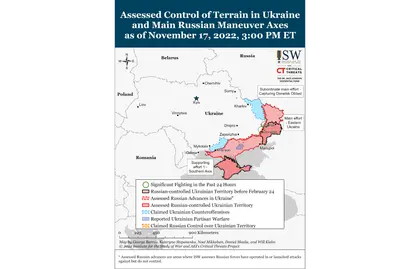Key Takeaways
- Russian forces conducted another massive wave of missile strikes across Ukraine on November 17
- Russian forces in eastern Kherson Oblast are likely partially vulnerable to a Ukrainian interdiction campaign such as the one Ukrainian forces successfully exploited to retake western Kherson Oblast.
- Russian President Vladimir Putin signed a decree changing the composition of the Russian Presidential Council for Civil Society and Human Rights (HRC) on November 17.
- Russian sources continued to claim that Ukrainian troops are conducting counteroffensive operations along the Svatove-Kreminna line.
- Russian forces continued ground attacks around Bakhmut, Avdiivka, and southwest of Donetsk City.
- Ukrainian troops continued targeting Russian military assets and concentration areas on the east bank of Kherson Oblast and in the rear areas of Zaporizhia Oblast on November 17.
- Russian authorities continue to face discontented mobilized personnel and low morale on the front lines.
- Russian occupation officials continued to destroy Ukrainian culture in Russian-occupied territories.
Russian forces conducted another massive wave of missile strikes across Ukraine on November 17. The Ukrainian General Staff reported that Russian troops launched five airstrikes and 25 cruise missile strikes at civilian infrastructure objects in Dnipropetrovsk, Odesa, Kharkiv, Zaporizhia, Dnipropetrovsk, and Mykolaiv oblasts throughout the day.[1] Ukrainian Air Force Command noted that Ukrainian air defense forces destroyed four cruise missiles, five Shahed-136 drones, and two Kh-59 guided missiles.[2] Russian forces conducted the largest missile attack since the start of the war on November 15, and as ISW has previously assessed, such missile campaigns are consuming Russia’s already depleted store of precision munitions.[3]
Russian forces in eastern Kherson Oblast are likely partially vulnerable to a Ukrainian interdiction campaign such as the one Ukrainian forces successfully exploited to retake western Kherson Oblast. Several major ground lines of communication (GLOCs) run through eastern Kherson Oblast into other Russian-controlled areas in southern Ukraine: the southern T2202 Nova Kahkovka-Armiansk route, the southeastern P47 Kakovkha-Henichesk route, and the M14 highway that runs eastward into Melitopol, Berdyansk, and Mariupol. Geolocated satellite imagery indicates that Russian troops are establishing defensive positions along some of these critical GLOCs, and social media reporting indicates that Ukrainian strikes have already begun targeting Russian concentration areas and military assets on these routes.[4] The limited number of high-quality roads and railways in this area, particularly connecting Crimea to the mainland, creates potential bottlenecks that could be vulnerable to Ukrainian interdiction efforts that would gradually degrade the Russian ability to continue supplying its grouping in eastern Kherson Oblast and other areas of southern Ukraine. ISW previously reported the targeting of similar bottlenecks along key GLOCS–not just the bridges across the Dnipro River–during Ukraine’s Kherson counteroffensive in late August to mid-October culminated in the Russian withdrawal from the west bank of Kherson Oblast to positions further south of the Dnipro River. Ukrainian forces will likely find it harder to achieve such dramatic effects in eastern Kherson but may be able to disrupt Russian efforts to solidify and hold their new defensive lines.

Kyiv Hit by Massive Drone Attack as Russian Strikes Target Multiple Ukrainian Cities
Russian President Vladimir Putin signed a decree changing the composition of the Russian Presidential Council for Civil Society and Human Rights (HRC) on November 17.[5] The decree notably expels four Russian human rights activists, including Ekaterina Vinokurova, who wrote a piece criticizing the rise of “patriotic” Telegram channels and nationalist milbloggers who have cornered the information space against opposition outlets who deviate from the predominant Kremlin line of the war in Ukraine.[6] Russian media previously reported that Vinokurova and other members of the HRC appealed to the Russian Investigative Committee to look into the widely circulated video of the execution of a former Wagner Group fighter who reportedly defected to Ukraine.[7] Putin’s new appointees to the HRC include a slate of Russian political and proxy members and notably Sasha Kots, a prominent milblogger and war correspondent who has been heavily involved in covering Russian operations in Ukraine.[8] Kots most recently called for Russia to maintain massive missile strikes against critical Ukrainian infrastructure on November 17.[9] This decree likely represents the Kremlin’s wider effort to stifle domestic civil opposition by continuing to platform prominent voices in the information space that propagate the Kremlin’s line on the war in Ukraine.
See the full report here.
You can also highlight the text and press Ctrl + Enter






